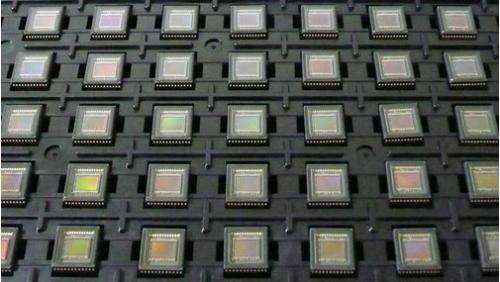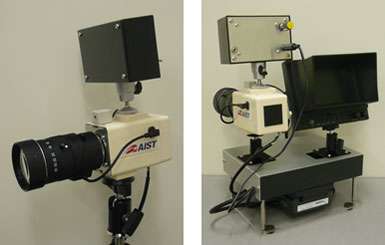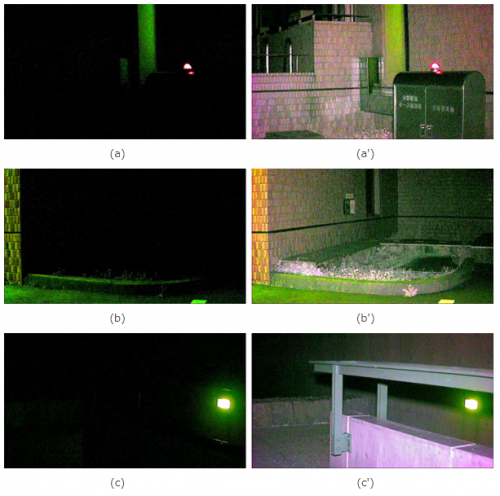Development of an image sensor for an infrared color night-vision camera

Researchers have developed an image sensor for infrared color night-vision imaging in collaboration with Sharp Corporation (Sharp; Division Deputy General Manager & Unit General Manager, Sensing Device Unit, Electronic Components and Devices Division: Norihiro Hondo).
The developed image sensor is a new type of image sensor that realizes videos having high definition and high frame rate of the AIST night-vision technology that can record color videos even in darkness (Photo 1). Furthermore, the image sensor makes a video recording device smaller as the image sensor can be applied to single-plate method video recording. Moreover, price reduction is also possible through mass production. The expansion of applicable ranges of the infrared color night-vision imaging technology, the development of new applications, and so forth are expected, through advancements in miniaturization and price reduction of the video recording devices.
The market size of the security cameras such as surveillance cameras, crime prevention cameras, and so on has been rapidly expanding, and is expected to exceed 10 million units in the world in 2014. Inexpensive products formed by Asian manufacturers already circulate in the world security camera market, where it is assumed that Japanese manufacturers will face severe price competition due to their high labor costs. In order to differentiate Japanese products from inexpensive ones, there are calls for the development of security cameras with high performance and high added value using the Japanese advanced technology.

AIST has developed the infrared color night-vision imaging technology that can obtain color videos of objects using only infrared illumination (AIST press releases on February 8, 2011 and on December 3, 2012). The technology performs the color processing based on the weak correlation between the reflectance properties in the visible light region of objects and those in the infrared region, and obtains color images of the objects in the same or similar colors as the colors of the objects in visible light. However, the infrared color night-vision cameras such as the 3-CCD method (3-plate method) camera that had experimentally been produced were somewhat large and were not suitable for general use.
Therefore, AIST, in collaboration with Sharp, has proceeded the development of the image sensors for the color night-vision cameras that realizes downsizing of cameras by using the unique and most advanced nanotechnology.
Photo 1 shows the external appearance of the developed image sensors. The 35 image sensors in total that are individually packaged with the resin mold packages and the cover glass lids are held in each compartment of the anti-static electricity tray. The dimensions of the top surface of the package are approximately 10 mm x 10 mm. The developed image sensor can record infrared color videos as smooth as 30 fps with high resolution of HD720 (1280 x 720 pixels).

Photo 2 shows the infrared color night-vision camera made using the developed image sensor for the infrared color night-vision recording. The dimensions of the main body of the camera are approximately 55 mm x 60 mm x 90 mm, and its weight is approximately 250 g. As the camera is small and light then easy to be carried and installed, it can be applied to various purposes.
Photo 2 (a) shows a camera equipped with a zoom lens and an infrared irradiation device on the left and top sides, respectively, of the main body of the camera in ivory color, which is fixed on a camera platform. Photo 2 (b) shows the total set for video recording including a monitor, a recorder, and a battery. This set enables the video monitoring and recording of objects at distances up to approximately 5 m even in darkness.
Photo 3 shows snapshots from the video (1 frame) in recording the outdoors at nighttime using this set. Photo 3 (a), (b), and (c) show images recorded without the infrared irradiation, which show images similar to those seen by the naked eye. On the other hand, Photo 3 (a'), (b'), and (c') show images recorded with the infrared irradiation. If the images in Photo 3 on the left side and on the right side are compared, the portions not visible in the left side images are clearly seen in the right side images, showing that color night-vision imaging was performed.
Currently, further performance enhancement of the developed image sensor is being advanced. The development of further enhanced infrared color night-vision cameras and infrared irradiation devices is ongoing at Sharp and Nanolux co., ltd. to put them on the market in fiscal year 2014.
Provided by Advanced Industrial Science and Technology





















